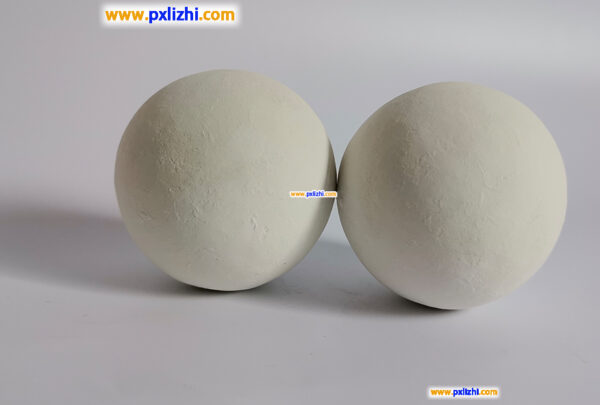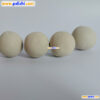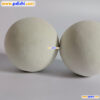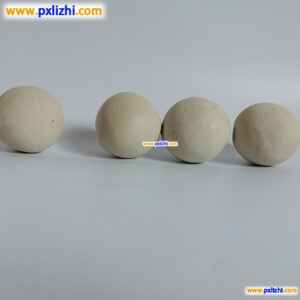Supplier Introduction
We are a professional supplier of inert alumina ceramic balls. Our company was established in 2004 and is located in Xiangdong District, Pingxiang City, Jiangxi Province, China. The company covers an area of 40 mu and has a building area of 18,000 square meters. The fixed assets amount to nearly 30 million yuan. We produce nearly 8,000 tons of inert alumina ceramic balls annually. Currently, we have 106 employees, among whom 12 have a college degree or above, 15 are professional technicians, and 18 are production managers. Our products are widely used in industrial towers for metallurgy, coking, petrochemicals, fertilizers, pharmaceuticals, acid production, thermal power generation, etc. The usage effect of various inert alumina ceramic balls produced by our company is good. In 2007, we obtained the right to engage in foreign trade and import and export. Our output is sold far and wide to twenty-plus countries including the United Kingdom, France, Italy, Morocco, the United States, Mexico, South Korea, the Philippines, Singapore, Japan, etc., and have received unanimous praise from customers.

Supplier Advantage
Due to our long-term focus on technological innovation and research and development of inert alumina ceramic balls, our quality is more reliable. Moreover, as we are a direct manufacturer and integrate production and trade, our inert alumina ceramic balls are also very cost-effective in terms of price-performance ratio.
Contact Information
Contact Person: Li Zhi
E-mail: lizhi@pxball.cn
WeChat ID: pxlizhi
Telephone: 86-15179935250
Address: Xiangdong Ceramic Industrial Park, Pingxiang City, Jiangxi Province, China
Key points of quotation
Clarify technical requirements: Specific specifications of inert alumina ceramic balls, such as diameter, density, compressive strength, chemical stability, etc. Due to the differences in performance indicators required by different application scenarios (such as petrochemicals, fertilizers, environmental protection, etc.) for inert ceramic balls, strict control of quality should be based on international standards, industry general standards (such as ASTM, ISO related standards), or customer special requirements. When quoting, clearly state the quality standards implemented by the product to let customers understand the quality level.
Packaging requirements: Inert alumina ceramic balls are selected with appropriate packaging materials and methods according to transportation requirements. For example, conventional packaging methods include plastic woven bags lined with plastic bags inside, or wooden cases and iron drums. These packaging methods will affect the final quotation.
Delivery location: The transportation costs vary for different delivery locations. Common trade terms such as FOB (Free On Board, delivery at the named port of shipment), CIF (Cost, Insurance and Freight, delivery at the named port of destination), EXW (Factory Delivery Price) correspond to different divisions of seller’s responsibilities, costs and risks. When quoting, it is necessary to be clear and let customers understand the respective responsibilities and cost ranges they bear.
Exchange rate fluctuation: Since export business is mostly settled in international common currencies (such as US dollars), exchange rate fluctuations will affect actual profits. When quoting for inert alumina ceramic balls, fully consider the factors of exchange rate fluctuations and take appropriate measures to avoid exchange rate risks. For example, negotiate in the contract to stipulate exchange rate fluctuation adjustment clauses, or use financial tools for hedging.
Product Parameters
| Property | Ceramic ball | Low alumina ball | Med. alumina ball | High alumina ball | Corundum ball | |
| Chemical composition % | Al2O3 | 20-30 | 31-45 | 46-70 | 71-90 | >90 |
| Al2O3+SiO2 | ≥90 | |||||
| Fe2O3 | ≤1 | |||||
| Water absorption, % | ≤5 | |||||
| Acid resistance, % | ≥98 | |||||
| Alkali resistance, % | ≥80 | ≥82 | ≥85 | ≥90 | ≥95 | |
| Thermal shock resistance, ºC | ≥300 | ≥400 | ≥500 | ≥700 | ≥800 | |
| Thermal resistance, ºC | ≥1000 | ≥1200 | ≥1300 | ≥1400 | ≥1500 | |
| Crushing strength KN/grain | Φ10mm | ≥0.85 | ≥1.0 | ≥1.20 | ≥1.50 | ≥1.90 |
| Φ13mm | ≥1.80 | ≥2.30 | ≥3.00 | ≥4.00 | ≥5.80 | |
| Φ16mm | ≥2.30 | ≥3.00 | ≥4.50 | ≥6.00 | ≥7.00 | |
| Φ20mm | ≥4.30 | ≥5.00 | ≥6.00 | ≥7.50 | ≥9.00 | |
| Φ25mm | ≥6.20 | ≥7.00 | ≥8.00 | ≥10.00 | ≥12.00 | |
| Φ30mm | ≥7.00 | ≥8.00 | ≥10.00 | ≥12.00 | ≥14.00 | |
| Φ38mm | ≥8.80 | ≥10.00 | ≥12.00 | ≥16.00 | ≥18.00 | |
| Φ50mm | ≥12.00 | ≥13.00 | ≥15.00 | ≥18.00 | ≥21.50 | |
| Φ76mm | ≥16.00 | ≥18.00 | ≥20.00 | ≥22.00 | ≥25.00 | |
| Bulk density, Kg/m³ | 1300-1400 | 1400-1500 | 1500-1600 | 1600-1800 | ≥1800 | |
| Note: The data of bulk density is given for reference only, not as the acceptance criterion. | ||||||










Reviews
There are no reviews yet.